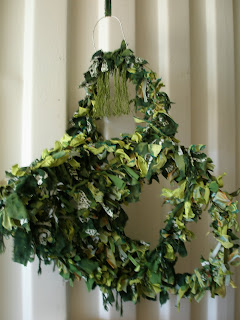A long post together with lots of pictures.
Here's the "Fork" piece, finally finished.

I'm pretty happy with the way this piece came out. Everything in this piece came from the disposal area - the box, utensils, keyboard keys, even the paper is reformed from the pages of a book I pulped and the definition of "fork" comes from a dictionary I found at the dump.
Today, I'm musing over how to present the Meditation on Color poem. I found a wonderful group of metal plates, six chargers and a serving tray, which I decided to use for this piece because they reflect the face of the viewer while you're looking at the piece - since the piece is a mediation on the meaning of color (as in the color of people), I really like the effect.
My original intention was to paint one of the masks (created with plaster and recycled paper) in a graduated rainbow. Here I've used a mask I painted a couple of years ago to see how the composition looked.

I don't like it as much as the plain white:

The next question is the placement of text. Whether it should be on the individual plates or surrounding the central mask. The final text will be printed on clear film rather than white paper so it won't stand out the same way.

And then, whether I like the individual plates surrounding the central in a halo or if it would be more effective as a rainbow arc. The benefit of placing the text on the individual plates is that the piece can be arranged either way, where if the text is on the central platter, it can only be displayed as a halo.

The poem itself is a variation on the sestina. The sestina form, according to Poets.org, is:
a complex form that achieves its often spectacular effects through intricate repetition. The sestina follows a strict pattern of the repetition of the initial six end-words of the first stanza through the remaining five six-line stanzas, culminating in a three-line envoi. The lines may be of any length, though in its initial incarnation, the sestina followed a syllabic restriction. The form is as follows, where each numeral indicates the stanza position and the letters represent end-words:
1. ABCDEF
2. FAEBDC
3. CFDABE
4. ECBFAD
5. DEACFB
6. BDFECA
7. (envoi) ECA or ACE
In true form, writing a sestina is kind of a form of madness, as far as I'm concerned. It's an exacting form, and most poets say that they only have one sestina in them. I call my poem a "fractured" sestina because it does not follow the strict repetition of the end words, rather, the subject of each line of the poem follows the repetition pattern (sometimes naming it and sometimes not). It does follow the rotation of the lines, though. I used the sestina form for this poem because the repetition of it feels very much like a double helix to me, which lent itself very nicely to the subject. Here's the poem:
The longest wavelength, perceived by the human eye, is 625-740 nm.
Existing between red and yellow, seen at 582-620 nm.
Stimulating both the long and medium wavelength receptors, at 570-580 nm.
Dominating the spectrum of energy at 520-570 nm.
A color whose wavelength is roughly 440-490 nm.
A general term for the color between red and blue, 420 – 400 nm.
Royalty, imperialism, nobility, penitence.
Aggression, blood, energy, passion, sacrifice, sin.
Desire, flamboyance, fire, warning.
Warmth and cowardice, caution and sunshine.
Growth, health, hope, nature, envy.
Water, winter, cold, sadness, ice and sky.
Homer called the Aegean “wine dark” sea, lacking the word for blue.
In 975 C.E., the English first learned the word for purple.
In Sanskrit, the word rudra means red.
Geoluhread became naranja became the name for the fruit orange.
Beowulf carried a shield made of yew, the color yellow.
Growen has always meant ‘to grow’ to be green.
Forest, moss, lime, viridian, malachite, celadon, chartreuse.
Cerulean, cobalt, Prussian, sky, baby, ultramarine.
Orchid, heliotrope, violet, lavender, han, tyrian.
Vermillion, scarlet, crimson, rose, ruby, carnation.
Tangerine, carrot, burnt, Gamboge, apricot, persimmon.
Cadmium, ochre, lemon, mustard, corn, saffron, school bus.
Pencils are painted yellow because the best graphite came from China.
Everyone wore tinted glasses to make things green in the Emerald City.
Depression and sadness are blue moods because when Zeus cried it rained.
Crushed snail shells gave Louis XIV purple robes in which to hide.
More nations use red in their flags than any other color.
Like silver and purple, orange has no true rhyme in English.
In 2001, Homeland Security terrorized us all with the color orange.
Chinks from Asia, flowing onto our shores, were a peril of yellow.
Witches were hanged for wearing the devil’s color, green.
Niggers without a drop of white blood were so black they were blue.
Fags and queers in Nazi Germany wore triangles of purple.
Savages and animals lived on the Plains in skin that was red.
We perceive red to be different from yellow or orange,
Want to believe green is dissimilar to blue or purple,
When, at the level of the atoms which make us whole,
Color
does not exist.
If you haven't had enough of the sestina form, follow this link to find out more.
www.poets.org/viewmedia.php/prmMID/5792
And here's an Airedale very confused at what all this stuff is doing in her house:

































